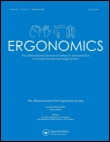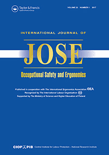
ERGONOMICS
Scope & Guideline
Fostering excellence in rehabilitation and therapy.
Introduction
Aims and Scopes
- Human Factors and Performance:
Research exploring how human factors impact performance across various tasks and environments, including cognitive workload, decision-making processes, and the effects of automation. - Occupational Health and Safety:
Studies focusing on ergonomics in workplace settings to prevent musculoskeletal disorders and enhance worker safety and well-being. - Design and Evaluation of Ergonomic Solutions:
Development and assessment of ergonomic tools, technologies, and systems, including exoskeletons, workstations, and assistive devices aimed at improving comfort and efficiency. - Human-Computer Interaction:
Investigations into user interface design and interaction that enhance usability and user experience, particularly in high-stakes environments such as aviation and healthcare. - Cognitive Ergonomics:
Research on cognitive processes and their implications for designing systems that support human cognition, including attention, memory, and decision-making. - Sociotechnical Systems:
Exploration of the interactions between humans and technology within complex systems, focusing on optimizing these interactions for safety and efficiency.
Trending and Emerging
- Wearable Technology and Exoskeletons:
Research into the design, implementation, and effects of wearable technologies, including exoskeletons, is on the rise, focusing on their potential to enhance physical capabilities and reduce injury risks. - Mental Workload and Cognitive Load Measurement:
A growing emphasis on understanding and measuring mental workload, particularly in high-stress environments, reflects the need for effective management of cognitive resources in workplace design. - Human-Robot Collaboration:
As automation and robotics become more prevalent, studies exploring effective collaboration between humans and robots are increasingly important, focusing on trust, task sharing, and ergonomics. - Sustainability and Ergonomics:
Research addressing the intersection of ergonomics and sustainability is emerging, emphasizing eco-friendly design practices and the ergonomic implications of sustainable technologies. - Diversity and Inclusion in Ergonomics:
There is an increasing focus on understanding how diversity (including gender, age, and ability) affects ergonomic design and workplace practices, promoting inclusive approaches in ergonomics. - Virtual and Augmented Reality Applications:
The use of virtual and augmented reality for training, design, and ergonomic assessments is gaining popularity, providing innovative ways to evaluate and enhance human performance in various contexts.
Declining or Waning
- Traditional Ergonomic Assessments:
Long-standing methodologies for assessing physical ergonomics, such as manual observation and basic ergonomic checklists, are being replaced by more advanced technologies and data-driven approaches. - Generalized Studies on Musculoskeletal Disorders:
Broad studies addressing musculoskeletal disorders without specific context or intervention strategies are less prevalent, as the field shifts towards targeted and context-specific research. - Static Postural Assessments:
Research focusing solely on static postural assessments without considering dynamic interactions and real-world applications has decreased, as the field moves towards more comprehensive analyses of human movement. - Aging and Gender Studies in Isolation:
While aging and gender remain important topics, studies that do not integrate these factors into broader ergonomic applications or workplace interventions are becoming less common. - Basic Human Factors Training Programs:
The emphasis on generic human factors training programs is declining in favor of specialized training tailored to specific industries or technologies, reflecting a need for more applicable and relevant skills.
Similar Journals

Frontiers in Neuroergonomics
Enhancing Human Experience with Cutting-Edge ResearchFrontiers in Neuroergonomics is an innovative journal published by Frontiers Media SA, dedicated to the interdisciplinary field that merges neuroscience with ergonomics. This open-access journal, represented by the E-ISSN 2673-6195, aims to enhance our understanding of human interactions with systems and environments through the lens of brain function and cognitive processes. With a commitment to high-quality research targeting both theoretical and practical applications, it provides a vital platform for researchers, professionals, and students to disseminate and discuss cutting-edge findings that have implications for design, safety, and usability in various industries. Situated in Switzerland, Frontiers in Neuroergonomics plays a crucial role in fostering collaboration and innovation in a rapidly evolving domain, making it an essential resource for those looking to bridge the gap between cognitive science and practical applications.

INTERNATIONAL JOURNAL OF HUMAN-COMPUTER INTERACTION
Transforming User Experiences Through ResearchINTERNATIONAL JOURNAL OF HUMAN-COMPUTER INTERACTION, published by Taylor & Francis Inc, stands at the forefront of research within the interdisciplinary fields of human-computer interaction, human factors, and ergonomics. Since its establishment, the journal has consistently contributed to advancing the understanding of the interactions between people and computers, making it a vital resource for researchers, professionals, and students alike. With an impressive impact factor reflecting its high citation rate, this journal is recognized as a Q1 publication in both Computer Science Applications and Human Factors and Ergonomics categories for 2023, showcasing its stature within the academic community. Additionally, it boasts a commendable ranking within the top percentiles in key areas on Scopus, ensuring that the research published here reaches broad scholarly audiences. Available in traditional subscription format, the journal covers seminal studies from 1989 to 2024, reflecting ongoing innovation in technology and its applications in everyday life, and thus serves as an essential platform for pioneering research that shapes the future of user experience.

Journal on Multimodal User Interfaces
Innovating Interfaces for a Smarter TomorrowJournal on Multimodal User Interfaces, published by Springer, serves as a vital platform for scholarly exchange in the rapidly evolving fields of Human-Computer Interaction and Signal Processing. Established in 2008 and continuing through 2024, this journal maintains a high profile in academia, currently ranking in the Q2 category for both fields, indicating its significant contribution to ongoing research and practical applications. With its Scopus rankings placing it at #34 in Signal Processing and #49 in Human-Computer Interaction, it is recognized for publishing high-quality, impactful research. Although it is not an Open Access journal, the Journal on Multimodal User Interfaces remains accessible through institutional subscriptions. Researchers, professionals, and students will find the journal an essential resource for advancing knowledge and fostering collaboration in multimodal interaction technologies, which are crucial for enhancing user experience and developing intelligent systems.

Journal of Health and Safety at Work
Transforming workplace safety with pioneering insights.The Journal of Health and Safety at Work, published by the Iranian Occupational Health Association, is a vital resource for researchers, professionals, and students engaged in the fields of occupational health, safety, and environmental management. With an ISSN of 2251-807X and E-ISSN 2383-2088, this Open Access journal has been dedicated to disseminating knowledge since 2012, ensuring that critical research is accessible to a global audience. The journal’s scope encompasses a diverse range of topics including human factors and ergonomics, safety research, and public health, with a focus on enhancing workplace safety and environmental standards. Although currently positioned in the Q4 category across various disciplines within safety and health research, the journal offers a unique platform for emerging studies and innovative practices, making it a significant contributor to the discourse in these fields. The journal's commitment to open access aligns with the growing trend of transparent scholarship, thus facilitating the sharing of vital insights to improve workplace health and safety outcomes. Researchers aiming to publish groundbreaking studies in this pivotal area will find the Journal of Health and Safety at Work an indispensable avenue for advancing knowledge and fostering professional collaboration.

International Journal of Occupational Safety and Ergonomics
Transforming safety research into real-world solutions.International Journal of Occupational Safety and Ergonomics, ISSN 1080-3548, is a leading multidisciplinary journal published by TAYLOR & FRANCIS LTD with a dedicated focus on advancing research and practices in occupational safety and ergonomics. Since its inception in 1995, this journal has provided a platform for the dissemination of innovative studies that address critical issues in public health, environmental and occupational health, and safety research. Recognized for its rigorous peer-review process, the journal holds a respectable position in the Q2 quartile rankings across multiple categories as of 2023, reflecting its impact and relevance within the academic community. It ranks 24th out of 109 in Safety Research, 198th out of 665 in Public Health, and 66th out of 207 in Safety, Risk, Reliability and Quality, showcasing its influence in these essential fields. The journal's broad scope aims to bridge gaps between research and application, ensuring that findings contribute to effective safety practices in various industries. While not an Open Access journal, the International Journal of Occupational Safety and Ergonomics remains an invaluable resource for researchers, professionals, and students seeking to stay informed about the evolving landscape of occupational safety. Its headquarters are located in Abingdon, England, serving as a conduit for scholarly communication in this vital area of study.

ACM Transactions on Applied Perception
Pioneering Research at the Crossroads of Psychology and ComputingACM Transactions on Applied Perception is a leading journal published by the Association for Computing Machinery, focusing on the intersection of perception science and computational methods. With an ISSN of 1544-3558 and an E-ISSN of 1544-3965, this esteemed publication has been a vital resource for innovators and researchers since its establishment in 2004. It operates within the ambit of Computer Science and the realms of Experimental and Cognitive Psychology, boasting a commendable impact factor and category rankings, including Q2 in Computer Science (miscellaneous) and Q3 in both Experimental and Cognitive Psychology and Theoretical Computer Science. The journal's scope encompasses a plethora of studies aimed at understanding human perception through computational lenses, making it an essential platform for scholarly exchange. Although it does not currently offer an Open Access option, its extensive reach and rigorous peer-review process ensure high visibility and impact in the academic community. By fostering collaboration across disciplines, ACM Transactions on Applied Perception encourages advancements that bridge perceptual research with practical applications, making it invaluable for researchers, professionals, and students engaged in this dynamic field.

ACM Transactions on Computer-Human Interaction
Exploring the Future of Human-Computer InteractionACM Transactions on Computer-Human Interaction (ISSN: 1073-0516; E-ISSN: 1557-7325) is a prestigious journal published by the Association for Computing Machinery, focusing on the dynamic and rapidly evolving field of Human-Computer Interaction (HCI). With an impressive 2023 impact factor reflecting its high-quality research output, it proudly holds a Q1 ranking in the HCI category on Scopus, positioning it among the top journals in the field. Established in 1994, the journal has been a vital resource for researchers and professionals alike, featuring innovative studies that explore the design, evaluation, and implementation of user interfaces and interactive systems. Its broad scope encompasses various aspects of HCI, including cognitive processes, user experience design, and the social implications of technology. As an essential read for anyone involved in HCI research and practice, the journal is a gateway to advancements that shape the future of human-technology interactions. The journal is accessible to readers globally, and it plays a pivotal role in disseminating knowledge that drives excellence in software design and user interface research.

PROCEEDINGS OF THE INSTITUTION OF MECHANICAL ENGINEERS PART D-JOURNAL OF AUTOMOBILE ENGINEERING
Elevating Standards in Mechanical and Aerospace EngineeringPROCEEDINGS OF THE INSTITUTION OF MECHANICAL ENGINEERS PART D-JOURNAL OF AUTOMOBILE ENGINEERING, published by SAGE PUBLICATIONS LTD, is a premier peer-reviewed journal dedicated to advancing the field of automobile engineering. Established in 1989, this journal serves as a vital platform for researchers, professionals, and students interested in the latest advancements in automotive technology and engineering practices. With a significant focus on aerodynamics, vehicle dynamics, and safety innovations, it consistently ranks in the Q2 quartile within both Aerospace Engineering and Mechanical Engineering, showcasing its influence and reliability in the academic community. The journal is indexed in Scopus with impressive rankings, being placed in the 41st percentile for Aerospace Engineering and the 214th percentile for Mechanical Engineering, further solidifying its importance in these fields. As an important resource for cutting-edge research, the journal does not currently offer open access, making it a great venue for disseminating substantial findings that drive the future of automotive innovation.

Cognition Technology & Work
Innovating Insights into Technology and Human ThoughtCognition Technology & Work, published by SPRINGER LONDON LTD, is a premier journal dedicated to exploring the multifaceted interactions between cognitive processes and technological applications in various work environments. With an ISSN of 1435-5558 and an E-ISSN of 1435-5566, this journal has established itself as a critical resource for scholars and practitioners in the fields of Computer Science, Human-Computer Interaction, and Philosophy. Evaluated in the 2023 Journal Citation Reports, it holds impressive category quartiles, ranking Q2 in Computer Science Applications and Human-Computer Interaction, and Q1 in Philosophy, highlighting its significant impact in academic discourse. Furthermore, its Scopus rankings showcase its robust standing, particularly within the Arts and Humanities and Computer Science sectors. Adopting a rigorous peer-review process, the journal aims to foster scholarly communication and advancement in the understanding of cognitive influences on technology in the workplace. It serves as an essential platform for researchers, professionals, and students alike, providing insight into innovative methodologies and theoretical frameworks that shape the future of cognitive technology in work settings.

Indian Journal of Occupational and Environmental Medicine
Advancing Knowledge in Occupational and Environmental HealthIndian Journal of Occupational and Environmental Medicine, published by Wolters Kluwer Medknow Publications, is a pivotal resource in the field of public health, focusing on the critical intersections of occupational safety and environmental health. With the ISSN 0973-2284 and E-ISSN 1998-3670, this journal has been a beacon of knowledge since its inception in 1999 and continues to influence scholarly discourse through its convergence years culminating in 2024. Recognized for its contribution to the field with a 2023 Scopus categorization of Q3 in Public Health, Environmental and Occupational Health, it has secured its place among the top journals, ranked #453 out of 665 within its specialty, reflecting a respectable 31st percentile. While it operates on a subscription basis, the journal ensures comprehensive coverage of significant research, thereby enhancing occupational health practices and environmental health policies. It serves as a vital platform for researchers, professionals, and students dedicated to advancing knowledge and improving outcomes in these crucial areas of health. The journal's commitment to excellence is evident as it continues to cater to a diverse readership from its base in Mumbai, India.